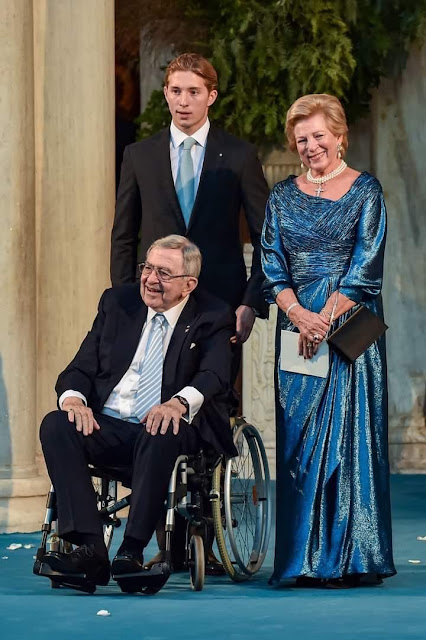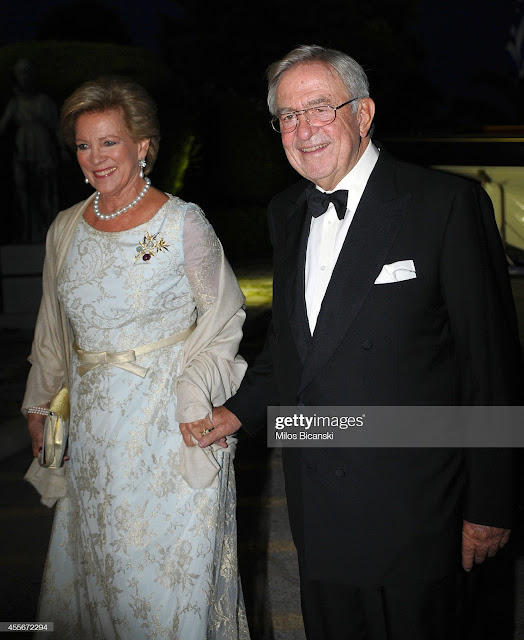 |
| El rey Constantino y la reina Ana María, con su nieto Constantino, en la boda de su hijo Filipo. |
 |
| El príncipe heredero Pavlos y la princesa heredera Frederica con sus hijos, la princesa Sofía y el príncipe Constantino. |
 |
| El Rey y la Reina de Grecia con sus tres hijos. |
El príncipe Constantino de Grecia y Dinamarca nació en la villa de Psychiko, hogar de sus padres, el 2 de junio de 1940. Una salva de 101 cañonazos desde el Monte Licabeto a las 6 de la tarde de esa tarde anunció a Atenas que un nuevo príncipe había llegado al mundo. La princesa heredera Federica recordó: “ Mis dos hijos mayores, Sophie y Constantine, nacieron en mi sala de estar en nuestra pequeña casa. Mis padres vinieron para el nacimiento de Sophie pero, cuando nació Tino, la guerra ya había comenzado y no pudieron venir. Palo [Paul] se quedó conmigo todo el tiempo y me cogió la mano. El Primer Ministro se sentó abajo con el Rey, porque era costumbre que el Primer Ministro estuviera en la casa ”. La Acrópolis se iluminó para celebrar el nacimiento del príncipe y se dispararon cañonazos en todo el país en señal de saludo. El bebé recibió el nombre de su abuelo paterno, el rey Constantino I de Grecia; el príncipe Constantino fue bautizado el 20 de julio de 1940 en la Catedral Metropolitana. El príncipe fue el primer hijo y segundo vástago del príncipe heredero Pablo de Grecia y la princesa heredera Federica (nacida princesa de Hannover), que se casaron en 1938. Constantino se unió a una hermana mayor, la princesa Sofía (nacida en 1938); le siguió una hermana menor, la princesa Irene (nacida en 1942). En el momento de su llegada, el tío de Constantino, Jorge II, era rey de Grecia; el infante príncipe era segundo en la línea de sucesión después de su padre Pablo.
 |
| The Greek Royal Family in 1959 Left to right: Crown Prince Constantine, Princess Irene, Queen Frederica, King Paul, Princess Sophia, and Prince Michael. Photograph (c) Getty Images / Dean Loomis. |
When Crown Prince Constantine came of age in 1958, he swore allegiance to his father and to the Greek people. On the crown prince’s eighteenth birthday on 2 June 1958, King Paul delivered this address to his only son:
Constantine,
God has graciously destined you to reign over this glorious, gallant and noble Nation of ours.
This sacred favour given to you, is an outstanding mark of honour and a legacy of great responsibility.
As from this day, you shall be my partner in the endeavour to further the progress and well-being of my people.
I am confident that your love of the Greek People, equal as it is to my own profound affection for them, will bring you as great happiness as it brings to me. In paying the price of their glorious history and enduring the consequences of their age-long struggles even to this day, in defence of mankind, the Greek People have not as yet been able to develop their capabilities to the full and achieve the standard of well-being to which they are justly entitled. For this very reason, they deserve every mark of affection and regard and every act of sacrifice on your part.
Be a just, kind and indefatigable worker for the advance and glory of Greece. Uphold steadfastly the Democratic Principles of our institutions and the Constitutional Liberties of our People.
Devote your life to the happiness of the Country. There is no task more noble and more important than this. Always remember that it is preferable that the King should suffer than that the suffering should fall on the Nation and the Country. Endeavour to show yourself worthy of the Greek Soldier whose leader you will be in the future. When the time comes, you will take your place at the head of the Greek Armed Forces, the bearers of a heroic and glorious tradition.
Keep them devoted to duty and battle-worthy, the guardians of our tradition, respected by our friends and feared by our foes, the priceless jewel of a proud Nation. May they never be forced to strike.
Be the protector and guardian of our Holy Church. Draw your strength from the love between you and your people. Redress offence by pardon, Discord by unity, Error by truth, Doubt by faith.
I pray that you and my People may know days of glory in the noble struggle for progress and civilisation.
May God Almighty make you an instrument of peace and always keep guard over Greece and over your, Constantine, my son.
In 1959, at the age of nineteen, Constantine met his future wife, his third cousin Princess Anne-Marie of Denmark, aged thirteen, on a visit to Denmark. Anne-Marie was the third and last daughter of King Frederik IX of Denmark and Queen Ingrid. Constantine and Anne-Marie met a second time in Denmark in 1961, when Constantine declared to her parents his intention to marry Anne-Marie; at this point King Frederik briefly locked Constantine in the toilet. They met again in Athens in May 1962 at the marriage of Constantine’s sister Princess Sofia of Greece and Denmark to Prince Juan Carlos of Spain at which Anne-Marie was a bridesmaid: and again in 1963 at the centenary celebrations of the Greek monarchy.
 |
| Crown Prince Constantine. |
When he was on a tour of the United States, Constantine spent time with his cousin King Simeon II of Bulgaria, who at that time was a student at the military school at Valley Forge. The two royals were pulled over by a policeman. Though neither Constantine nor Simeon had identification on them, they presented themselves as “Crown Prince of Greece” and “King of Bulgaria.” Needless to say, they were briefly arrested before the Greek embassy intervened and verified their identities. In 1960, aged twenty, Crown Prince Constantine won an Olympic gold medal in sailing, which was the first Greek gold medal in sailing since the Stockholm 1912 Summer Olympics. He was also a strong swimmer and had a black belt in karate.
 |
| King Constantine II of Greece with Queen Mother Frederica at the funeral of King Paul. Pictured behind them is Princess Irene. Photograph (c) Getty Images / Jack Garofalo. |
 |
| King Constantine II of Greece with his mother Queen Frederica at the funeral of King Paul. Photograph (c) Getty Images / Keystone. |
Aged sixty-two, King Paul I of Greece died at Athens on 6 March 1964, and Constantine succeeded to the throne. In his biography of the new king, entitled HM Konstantine XIII, G. Nicholas Tantzos presented Constantine’s daily routine once he became monarch: “The King’s average day commenced about 7:30 AM with a breakfast of coffee, boiled eggs and toast, after which he read the newspapers and smoked his first cigarette. Unless there were formal meetings, the King dressed casually in slacks and sweater. By 9 AM he commenced conferences with his staff, going over state papers, and holding audiences, and attending meetings. Lunch was scheduled for 1:30 PM, but the King was usually late. In the afternoon he sometimes played squash with the Assistant Military Attache from the American Embassy, then returned to his office. There were many royal duties: opening factories, trade fairs, presiding over international functions and charitable institutions, reviewing military parades and such. His day usually ended after 9:30 PM in the evening, when he returned to the Palace. Sometimes he listened to music or watched a movie in the Palace basement, or had friends around for drinks.“
 |
| King Constantine and Queen Anne-Marie of Greece on their wedding day, 1964. Photo (c) Getty Images / David Lees. |
 |
| King Constantine, Queen Anne-Marie holding Crown Prince Pavlos, Queen Mother Frederica, and Princess Irene of Greece photographed in Rome, 1967. Photo (c) Rolls Press / Popperfoto. |
 |
| King Constantine holding Prince Nikolaos and Queen Anne-Marie in Rome, 1969. Photo (c) Getty Images / Rolls Press / Popperfoto. |
 |
| King Constantine and Queen Anne-Marie celebrate their Golden Wedding anniversary, 2014. Photo (c) Getty Images / Milos Bicanski. |











No comments:
Post a Comment